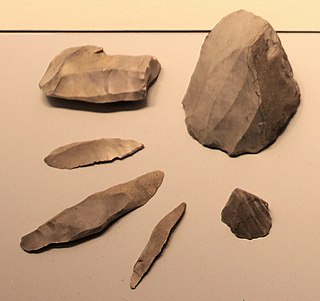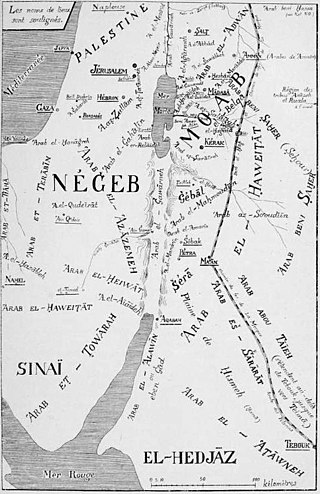Related Research Articles

The Epipalaeolithic Near East designates the Epipalaeolithic in the prehistory of the Near East. It is the period after the Upper Palaeolithic and before the Neolithic, between approximately 20,000 and 10,000 years Before Present (BP). The people of the Epipalaeolithic were nomadic hunter-gatherers who generally lived in small, seasonal camps rather than permanent villages. They made sophisticated stone tools using microliths—small, finely-produced blades that were hafted in wooden implements. These are the primary artifacts by which archaeologists recognise and classify Epipalaeolithic sites.

A microlith is a small stone tool usually made of flint or chert and typically a centimetre or so in length and half a centimetre wide. They were made by humans from around 35,000 to 3,000 years ago, across Europe, Africa, Asia and Australia. The microliths were used in spear points and arrowheads.

Natufian culture is a Late Epipaleolithic archaeological culture of the Neolithic prehistoric Levant in Western Asia, dating to around 15,000 to 11,500 years ago. The culture was unusual in that it supported a sedentary or semi-sedentary population even before the introduction of agriculture. Natufian communities may be the ancestors of the builders of the first Neolithic settlements of the region, which may have been the earliest in the world. Some evidence suggests deliberate cultivation of cereals, specifically rye, by the Natufian culture at Tell Abu Hureyra, the site of earliest evidence of agriculture in the world. The world's oldest known evidence of the production of bread-like foodstuff has been found at Shubayqa 1, a 14,400-year-old site in Jordan's northeastern desert, 4,000 years before the emergence of agriculture in Southwest Asia. In addition, the oldest known evidence of possible beer-brewing, dating to approximately 13,000 BP, was found in Raqefet Cave on Mount Carmel, although the beer-related residues may simply be a result of a spontaneous fermentation.

The Bedouin, Beduin, or Bedu are pastorally nomadic Arab tribes who have historically inhabited the desert regions in the Arabian Peninsula, North Africa, the Levant, and Mesopotamia (Iraq). The Bedouin originated in the Syrian Desert and Arabian Desert but spread across the rest of the Arab world in West Asia and North Africa after the spread of Islam. The English word bedouin comes from the Arabic badawī, which means "desert dweller", and is traditionally contrasted with ḥāḍir, the term for sedentary people. Bedouin territory stretches from the vast deserts of North Africa to the rocky ones of the Middle East. They are sometimes traditionally divided into tribes, or clans, and historically share a common culture of herding camels, sheep and goats. The vast majority of Bedouins adhere to Islam, although there are some fewer numbers of Christian Bedouins present in the Fertile Crescent.

The Negev or Negeb is a desert and semidesert region of southern Israel. The region's largest city and administrative capital is Beersheba, in the north. At its southern end is the Gulf of Aqaba and the resort city and port of Eilat. It contains several development towns, including Dimona, Arad, and Mitzpe Ramon, as well as a number of small Bedouin towns, including Rahat, Tel Sheva, and Lakiya. There are also several kibbutzim, including Revivim and Sde Boker; the latter became the home of Israel's first Prime Minister, David Ben-Gurion, after his retirement from politics.

Shivta, originally Sobata or Subeita, is an ancient city in the Negev Desert of Israel located 43 kilometers southwest of Beersheba. Shivta was declared a UNESCO World Heritage Site in June 2005, as part of the Incense Route and the Desert Cities of the Negev, together with Haluza/Elusa, Avdat and Mamshit/Mampsis.
Lunate is a crescent or moon-shaped microlith. In the specialized terminology of lithic reduction, a lunate flake is a small, crescent-shaped flake removed from a stone tool during the process of pressure flaking.

Prehistoric Egypt and Predynastic Egypt span the period from the earliest human settlement to the beginning of the Early Dynastic Period around 3100 BC, starting with the first Pharaoh, Narmer for some Egyptologists, Hor-Aha for others, with the name Menes also possibly used for one of these kings.
In cultural anthropology, sedentism is the practice of living in one place for a long time. As of 2024, the large majority of people belong to sedentary cultures. In evolutionary anthropology and archaeology, sedentism takes on a slightly different sub-meaning, often applying to the transition from nomadic society to a lifestyle that involves remaining in one place permanently. Essentially, sedentism means living in groups permanently in one place. The invention of agriculture led to sedentism in many cases, but the earliest sedentary settlements were pre-agricultural.

Mount Sinai is the mountain at which the Ten Commandments were given to Moses by God, according to the Book of Exodus in the Hebrew Bible. In the Book of Deuteronomy, these events are described as having transpired at Mount Horeb. "Sinai" and "Horeb" are generally considered by scholars to refer to the same place.
The prehistory of the Levant includes the various cultural changes that occurred, as revealed by archaeological evidence, prior to recorded traditions in the area of the Levant. Archaeological evidence suggests that Homo sapiens and other hominid species originated in Africa and that one of the routes taken to colonize Eurasia was through the Sinai Peninsula desert and the Levant, which means that this is one of the most occupied locations in the history of the Earth. Not only have many cultures and traditions of humans lived here, but also many species of the genus Homo. In addition, this region is one of the centers for the development of agriculture.

Al-Khalasa, was a Palestinian village, located 23 kilometers southwest of the town of Beersheba. The village stood at the site of an ancient town from the Nabatean, Roman, Byzantine, and the beginning of the Early Muslim period. The ancient city, founded by the Nabateans, is known from Greek and Roman sources as "Halasa" or "Chellous", and later as "Elusa", one of the Byzantine administrative centers in the Negev Desert. Still important in the century of the Muslim conquest, it was deserted not long after. The site was repopulated by Bedouin in the early twentieth century, after western archaeologists took an interest in it. In October 1948, it was captured by Israel during the 1948 Arab-Israeli War. The population of al-Khalasa is unknown, but all of the inhabitants were Muslims, from the al-Azizma tribe.

Ramat HaNegev Regional Council is a regional council in the Negev desert in Israel. With around 8,000 residents spread across 20 villages, the council is geographically the largest in Israel, covering more than 20% of Israel's landmass. The council's headquarters are located on Highway 40 between Mashabei Sadeh and Tlalim.

The Negev Bedouin are traditionally pastoral nomadic Arab tribes (Bedouin), who until the later part of the 19th century would wander between Saudi Arabia in the east and the Sinai Peninsula in the west. Today they live in the Negev region of Israel. The Bedouin tribes adhere to Islam.
According to the Book of Numbers, Taberah is one of the locations which the Israelites passed through during their Exodus journey. The biblical narrative states that the place received its name, which means the pӀace of burning, because the fire of the LORD had burned there in anger because of their continued complaints. The text states that the fire first burned at the outskirts of the Israelite camp, killing some of those who lived on the edge of the group, but it was extinguished when Moses prayed on the people's behalf.

Auja al-Hafir was an ancient road junction close to water wells in the western Negev and eastern Sinai. It was the traditional grazing land of the 'Azazme tribe. The border crossing between Egypt and Ottoman/British Palestine, about 60 km (37 mi) south of Gaza, was situated there. Today it is the site of Nitzana and the Ktzi'ot prison in the Southern District of Israel.

The Mushabian culture is an archaeological culture suggested to have originated among the Iberomaurusians in North Africa, though once thought to have originated in the Levant.
Adrian Nigel Goring-Morris is a British-born archaeologist and a professor at the Hebrew University of Jerusalem in Israel.

The Tirabin, were the most important Arab tribe in the Sinai Peninsula during the 19th century, and the largest inside Negev. Today this tribe resides in the Sinai Peninsula but also in Cairo, Ismailia, Giza, Al Sharqia and Suez, Israel (Negev), Jordan, Saudi Arabia and the Gaza strip. A township named Tirabin al-Sana was built in Israel in 2004 especially for the members of al-Sana clan from Al-Tirabin tribe.
The Ahmarian culture was a Paleolithic archeological industry in the Levant dated at 46,000–42,000 BP and thought to be related to Levantine Emiran and younger European Aurignacian cultures.
References
- ↑ Byrnes, Andie. "The Origins & Spread of Agriculture". Chapter 3: Epipaeleolithic. Archived from the original on 11 April 2008. Retrieved 20 November 2019.